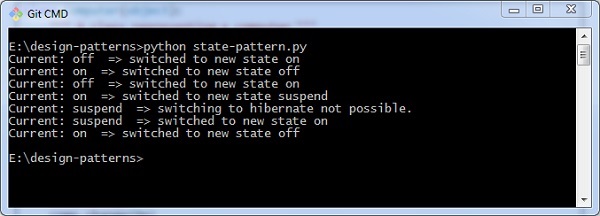狀態設計模式
它爲狀態機提供了一個模塊,它使用從指定的狀態機類派生而來的子類來實現。 這些方法獨立於狀態,並使用裝飾器聲明轉換。
如何實現狀態模式?
狀態模式的基本實現,請參考如下代碼 -
class ComputerState(object):
name = "state"
allowed = []
def switch(self, state):
""" Switch to new state """
if state.name in self.allowed:
print 'Current:',self,' => switched to new state',state.name
self.__class__ = state
else:
print 'Current:',self,' => switching to',state.name,'not possible.'
def __str__(self):
return self.name
class Off(ComputerState):
name = "off"
allowed = ['on']
class On(ComputerState):
""" State of being powered on and working """
name = "on"
allowed = ['off','suspend','hibernate']
class Suspend(ComputerState):
""" State of being in suspended mode after switched on """
name = "suspend"
allowed = ['on']
class Hibernate(ComputerState):
""" State of being in hibernation after powered on """
name = "hibernate"
allowed = ['on']
class Computer(object):
""" A class representing a computer """
def __init__(self, model='HP'):
self.model = model
# State of the computer - default is off.
self.state = Off()
def change(self, state):
""" Change state """
self.state.switch(state)
if __name__ == "__main__":
comp = Computer()
comp.change(On)
comp.change(Off)
comp.change(On)
comp.change(Suspend)
comp.change(Hibernate)
comp.change(On)
comp.change(Off)執行上述程序生成以下輸出 -
